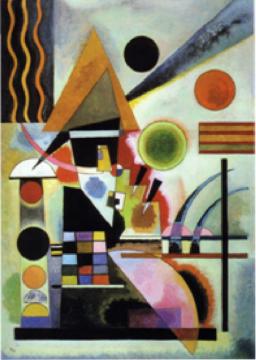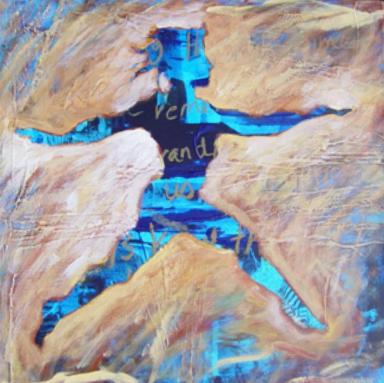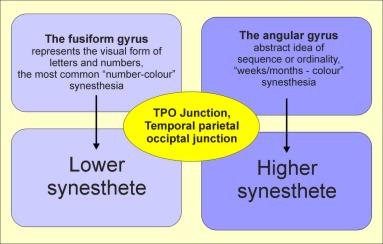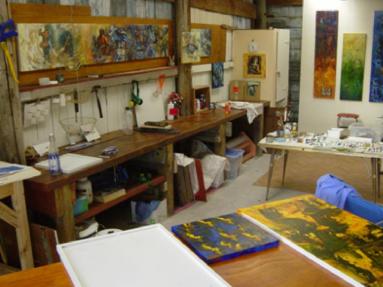



|

|

|
|
|
||
| Back | Home | Next |
CHAPTER FIVEMETAPHORICAL SYNESTHESIA IN ART PROCESSES: |
 |
Figure 29 Kadinsky, Swinging, 1925, oi on board, 70.5 x 50.2 cm, Tate Gallery, London (20th Century Art, 2000). |
Kandinsky (1886-1944) wanted the spectator to "feel his way into the painting" and "have the work's meaning carried immediately and directly to the spectator" (Stangos, 1974, p.41). He used musical metaphors as titles for these works (Figure 28), which underlines the synesthetic principles in his work from this time.
It wasn't until Asher began studying neuroscience at Harvard, that he learned there was a name for this phenomenon (Underwood, 2003) - synesthesia, from the Greek roots syn (together) and aesthesis (perception). Almost any two senses can be combined.
Another neurobiologist at U.C. San Diego, Professor Ramachandran, has also been researching synesthetic tendencies. "Maybe metaphor, abstract thought and synesthesia all have a similar neural basis" (Ramachandran, 2003). "Clearly, synesthesia is related to creativity. A new survey by [Peter] Grossenbacher found that out of 84 synesthetes, 26 were professional artists, writers or musicians, and 44, serious amateurs" (Underwood, 2003). Ramachandran says that "synesthesia ...is part and parcel of what ends up being a more expressive life" (cited in Underwood, 2003).
 |
Figure 30 Shāna Carlan-Riddell, Skip, 2003, photomechanical screen printing, oil and acrylic on board, 40 x 40 cm. |
Linking back to chapter one, Albright states that "metaphors are the only proper way to describe the remembered self, since memory itself is only a metaphor, a dim surrogate for past time that can never be recovered, never embodied, never made to sit still" (1994, p. 38). For example, in Figure 29 I use skipping as a metaphor to suggest the physical experience of remembering. The processes I use in my studio explore, reduce, recover and reinterpret symbolic metaphor through the experiences of colour, texture and composition within my paintings.
Not all synesthetes are made equal. Progress in neurobiological research has shown that there is more than one level of synesthesia, which helps explain the different levels of synesthetic experience. Professor Ramachandran proposes a neural mechanism in the brain involving cross activation between brain maps, and has found that it runs in families, which could explain why some families tend to be more artistically oriented, in music, drama or the visual arts (Ramachandran, 2003).
He suggests that such mechanisms may also explain the representation of metaphors and the evolution of language in humans. I believe this is important in my work, in that I assert that language is the site of the transfer of meaning for a narrative painter.
Ramachandran's lectures expand on his research. He says that:
"Roman numbers don't give synesthetes a vision of colours. Now what does that prove? It's very important because it shows it's not the numerical concept that drives the colour but the visual appearance of the Indian/Arabic number ...because the fusiform gyrus represents the visual appearance of numbers and letters and things like that, not the abstract concept of sequence or ordinality" (Ramachandran, 2003).
 |
Figure 31 The fusiform and angular gyrus' are the areas of the brain responsible for synesthesia (after Ramachandran, 2003). |
Ramachandran continues to explain that the structure of the area of the brain that appears to be responsible for synesthetic experiences is the temporal parietal occipital junction, or TPO junction. In this area of the brain, the fusiform gyrus is also found; one of its functions is in presenting the visual appearance of numbers and letters, and it generates the most common "number-colour" synesthesia (refer to Figure 30). There is also the angular gyrus, which represents the abstract idea of sequence or ordinality, responsible for synesthetes seeing colours for weeks or months of the year.
Dr. Ramachandran's BBC Reith radio lectures contained excellent points that directly related to my investigation about synesthesia and the visual arts. He stated that:
One of the odd facts about synesthesia which has been known for a long time and again been ignored, is the fact that synesthesia is [seven times more] common among artists, poets, novelists, you know flaky types! Why? What they all have in common is they're very good at metaphor, namely linking seemingly unrelated concepts in their brain, such as if you say "out out brief candle", meaning "life", why do you call it a candle? Is it because life is like a long white thing? Obviously not. You don't take the metaphor literally, although schizophrenics do and we won't go into that. So why do you that? Well it's brief like a candle, it can be snuffed out like a candle, it illumines like a candle very briefly. Your brain makes all the right links and Shakespeare of course was a master of doing this (Ramachandran, 2003).
The gift of metaphor which is generated by the anatomical conditions in the TPO junction is also a trait which is transmitted genetically from parents to children. This could help to explain why certain talents run in families, like music or the arts, and why these people have excess connections to make associations much more fluidly and effortlessly than all of the "less-gifted people" (Ramachandran, 2003).
 |
Figure 32 My studio in Rotorua, 2004. |
I believe that I experience synesthesia when I am in my studio (Fig. 31) and handling my materials, con-templating how to best re-present my thoughts, ideas and feelings into paint, ink, wood, shapes, colours, textures: objectifying inter-nal thoughts and feelings into works of art. I also suggest that there is another kind of synesthesia; not a literal or metaphoric kind, but an intuitive variety from which an artist operates, mainly without conscious manipulation. I believe that I can be in a state, that simultaneously has a presence as well as an absence of conscious thought, where designs and abstract patterns emerge based on physical experience. This is a nebulous and indefinable process that I cycle through as I create a body of work on my topic, and the understandings I have come to about synesthetic metaphor best describe these cycles.
The ability I have developed to integrate this synesthetic interpretation of my autobiogrpaphical subject matter has facilitated an increased depth of analysis and regeneration in my work. This has promoted an intensification and amplifying of the content inherent in the narrative by seeking and using metaphors in visual language for memories and personal identity.
|
|
||

|
Shāna Carlan-Riddell Paradise Valley RD2, Rotorua New Zealand |
shanacr@gmail.com Phone +64 (07) 350-2114 Mobile +64 027 659-6538 |
|
|
||